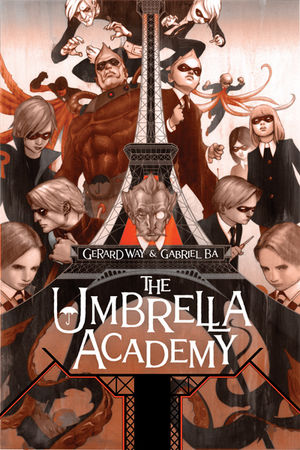 Part steam punk, part superhero comic and all attitude, Umbrella Academy is the brainchild of rock front man Gerard Way (My Chemical Romance). The titular “academy” is actually a group of oddly powered kids, raised by an eccentric space alien masquerading as an entrepreneur known for his work with chimpanzees. Truly. This first collection of stories briefly touches upon the kids’ provenance, then jumps forward ten years to show them saving Paris from the Eiffel Tower gone mad, then jumps forward twenty years, to the present, where they must save the world from a certain end.
Part steam punk, part superhero comic and all attitude, Umbrella Academy is the brainchild of rock front man Gerard Way (My Chemical Romance). The titular “academy” is actually a group of oddly powered kids, raised by an eccentric space alien masquerading as an entrepreneur known for his work with chimpanzees. Truly. This first collection of stories briefly touches upon the kids’ provenance, then jumps forward ten years to show them saving Paris from the Eiffel Tower gone mad, then jumps forward twenty years, to the present, where they must save the world from a certain end.
The members of the academy are better known by names which vaguely describe their powers or proclivities. Space, who had always wanted to go to space as a kid, is in fact a spaceman (and part ape-man now, as he has the body of a gorilla). Séance can talk to the dead and possesses telekinetic powers. Kraken can hold his breath and seems at home in the water. Everything that Rumor says comes true. 05 (no other name or designation given) can travel in time, and appears to be a ten year old boy, although internally he’s much older. Rounding out the group is a former member, Vanya, who’s always been told she will amount to nothing.
Fast-paced, occasionally to the point of confusion — particularly when it jumps in time — Umbrella Academy packs in the action, hurtling towards a predicted apocalypse in span of just six issues. At first, the team thinks the prime threat is an old enemy, Dr. Terminal, taking advantage of their return home for their “father’s” funeral. But the true enemy and apocryphal danger is much closer to home. Back story and motivations are kept to a minimum, just enough to make current events comprehensible. It’s very clear Way has a complex universe at work behind the scenes, and he drops tidbits here and there, tantalizingly, such as the unexplained disappearance of the seventh child, Ben. Or the contents of Vanya’s book that she wrote about her experiences as a part of the team. Or why a space alien was on earth raising child prodigies and experimenting with chimps. There’s more here to discover, now that the world’s been saved.
After the main story, there’s a gallery of early character conceptions; some, like Space, changed a fair amount by the time the comic was underway. Others, like Kraken, seem fully-realized from the outset.
Closing out the volume are two shorts, “Mon Dieu” (in which 05 sends Séance back in time to a French battle), and the first published Umbrella Academy story, “. . . but the Past Ain’t Through With You.” In the latter, Rumor discovers a disturbing side effect of inadvertently using her powers on herself.
Gabriel Ba’s artwork is top-notch, particularly Vanya’s ultimate sexy design. So too the series’ covers, by James Jean, which precede each chapter.
Umbrella Academy won the 2008 Eisner award for Best Finite Series/Limited Series, and went on to a second series.
(Dark Horse Books, 2008)
